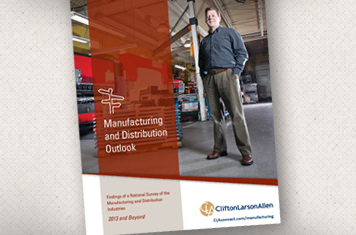
Economic uncertainty is now an accepted reality, but industry leaders are not letting it hinder growth, according to a CliftonLarsonAllen third annual survey of U.S. manufacturers and distributors.
Economic uncertainty is now an accepted reality, but industry leaders are not letting it hinder growth, according to CliftonLarsonAllen’s third annual survey of U.S. manufacturers and distributors.
“The attitude and mindset of the leaders we surveyed focuses on capturing opportunities instead of dwelling on things that can not be controlled,” says Erik Skie, manufacturing and distribution managing principal with CliftonLarsonAllen. “The industry has moved beyond the Great Recession and is now shaping its own future.”
Manufacturing and Distribution Outlook 2013 is a composite of opinions from hundreds of CLA clients and non-clients across the country. Seventy-five percent of respondents were privately held and family ownership businesses, 27 percent were one owner organizations, and 54 percent had two to five owners.
Focusing on The Value Triangle
This year’s survey centers on key areas that are essential for healthy and sustainable manufacturing and distribution organizations. We call it The Value Triangle, and it includes four dimensions: financial, growth, execution, and leadership. Excellence in any of these areas can create bursts of short-term success. However, consistent attention to all four creates high performance organizations that can compete in the global marketplace.
The observations received from industry leaders related to these four areas.
Financial
While many parts of our economy are nowhere near pre-recession levels of performance, approximately 70 percent of respondents say they are at or above pre-recession levels of profitability. The fact that U.S. manufacturers and distributors have navigated the turbulence of the past four years and returned to 2007 profitability levels is both significant and encouraging.
- Overall, respondents indicate that working capital requirements (including inventory) and availability of credit have not been deterrents to growth over the past two years.
- Cash flow challenges at the largest original equipment manufacturers (OEMs) have translated into extended payment terms for some suppliers. About 40 percent of respondents said the average age of accounts receivable has increased, while an almost equal number said account aging had stayed the same.
Growth
Exports account for half of overall U.S. economic growth since the end of the Great Recession, so we asked about export strategies.
- More than 63 percent of respondents said they are currently exporting, while approximately 27 percent said they have not exported and do not plan to start in the next two years. Three percent said they plan to begin export activities in the next two years.
- While much is made of the challenges of global competition, respondents do not see a meaningful difference between what it takes to compete domestically and abroad. High quality products, flexibility to meet customer needs, and customer service continue to be the attributes most mentioned by respondents as their keys to success.
Another issue that impacts long-term growth and sustainability is the management of revenue concentrations.
- The majority of respondents said they have an industry concentration that accounts for more than 50 percent of their revenue base. They clearly indicated that revenue concentrations are a risk that must be mitigated, but they also said concentrations often continue even as the geographic reach of a company becomes global.
Execution
The survey showed that continuous improvement is alive and well in manufacturing. For most companies, it has become a way of life.
- Sixty percent of respondents indicated that their continuous improvement efforts target market pressures like costs, quality, and on-time delivery; 19 percent aim to increase capacity; and just 7 percent said they are targeting inventory reduction.
- Roughly 70 percent said they are at or above pre-recession profit levels, but almost as many respondents (67 percent) feel they still have excess capacity.
- A shortage of skilled workers is an issue for more than half of survey respondents. Most say they are implementing workforce training, lean manufacturing, and automation to counter this trend.
Leadership
Many in the Baby Boom generation are reaching an age where they are planning for the next phase of their lives. Since small to mid-sized manufacturing ownership is dominated by Baby Boomers, it would be safe to assume that many leadership changes are on the horizon.
- Thirty-five percent said they are expecting an ownership transition in the next five years.
- When asked about the importance of this transition, 70 percent said that it is “somewhat important” or “very important.”
- There appears to be a correlation between the timing of future leadership transitions and the timing of expected ownership transitions.
Looking ahead
A year ago, manufacturing and distribution leaders were reporting that economic uncertainty, rising health care costs, and rising production costs were foremost on their minds. Though not as strong as last year, uncertainty remains a top concern in 2013, and will likely become an accepted reality as global economies and governments continue to resolve longer-term structural issues.
“The rising concern with finding and retaining skilled workers can be seen as both a positive and a negative,” says Skie. “The need for skilled workers coincides with an expansion in manufacturing, but the inability to fill skilled positions could ultimately hold manufacturers back from their full growth potential.”
“An unaddressed leadership void could also become a crisis,” Skie says. “Smaller companies often have questions about succession. Larger companies are worried about the sustainability of their smaller supply chain partners. Many survey respondents see the leadership void coinciding with a potential ownership transition.”
The innovation and resiliency that has been demonstrated by the owners and leaders of manufacturing and distribution companies is truly inspiring. While the most recent recession recast the competitive landscape for many industries, manufacturing and distribution have been meeting the challenge for well over a decade and continue to move forward. As we put the Great Recession behind us, the resiliency of American manufacturing continues to show itself as the strongest characteristics of all.
Download a complimentary copy of Manufacturing and Distribution Outlook 2013.
